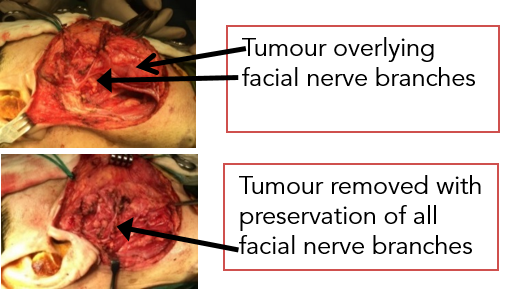What is Parotidectomy?
Parotidectomy refers to the surgical removal of the parotid gland. This gland is the largest of our major salivary glands.
Types of Parotidectomy
1. Superficial Parotidectomy:
Removal of the parotid tumour located on top of the facial nerve.
2. Deep Lobe Parotidectomy:
Removal of the parotid tumour located deep to the facial nerve. You may experience some weakness of facial movements after this procedure
3. Total Parotidectomy:
Removal of the entire parotid gland, usually performed for aggressive parotid cancers.
When is Parotidectomy Needed?
- Parotid cancers
- Benign parotid tumours with risk of becoming cancerous or recurrent infections
- To remove the lymph nodes within the parotid gland that are affected by the spread from other cancers of the head and neck region

How is the Surgery Performed?
- Performed under general anaesthesia
- A facial nerve monitor may be used
- Further details of the procedure will be provided by your ENT surgeon.
Preparation for Surgery
- You will undergo anaesthesia review and blood tests before the surgery to determine your fitness for surgery.
- Duration of surgery ranges from two to four hours, depending on the procedure and approach.
- You may need to stop aspirin and other blood thinning medications for seven to ten days before surgery to reduce the risk of bleeding. If you have to continue them for other medical reasons, please check with your ENT surgeon.
- Your surgery may be postponed if you develop a fever, cold, flu, sore throat or any other illnesses 24 to 48 hours before the day of surgery. Please inform the ENT clinic or surgeon if you feel unwell before the surgery.
What to Expect Immediately After the Surgery?
- Stitches and numbness around the wound site
- A neck drain may be placed around the wound site.
- You will be able to eat, drink and talk after the surgery
Possible Risks of Surgery
1. Facial Weakness
As the facial nerve runs closely within the parotid gland, you may experience temporary weakness of facial movements, such as closing your eyes and facial asymmetry. Permanent damage to the facial nerve is rare (unless caused by cancer).
2. Bleeding / Wound Swelling
A neck drain may be placed during surgery to facilitate drainage of excess fluid, prevent the formation of blood clots and collection of saliva.
3. Wound Site and Ear Lobe Numbness
Numbness around the wound site is common after surgery. This improves as the wound heals. Injury to the greater auricular nerve may also cause numbness of the ear lobe.
4. Frey’s Syndrome
This is a rare complication whereby patients develop sweating over the cheek area when they are eating or salivating. This occurs due to abnormal regeneration of nerve fibres that control salivation with the nerve fibres that control sweating.
5. Wound Scarring and Infection
Your doctor may prescribe antibiotics to treat any infection. The chance of scar or keloid formation is less than 1%.
6. First Bite Syndrome
This is uncommon and occurs in the removal of deep lobe tumours. You may feel pain on your first bite which subsequently improves with each bite.
Home Care After Surgery
1. Activity
You can resume normal activities as your condition improves.
2. Diet
There are no restrictions on your diet. However, a soft diet is advised if you have throat discomfort.
3. Medications
Take pain medications or antibiotics as prescribed.
4. Wound Care
Keep the exposed wound clean and dry. Check your wound daily for:
- Redness
- Swelling
- Discharge (blood, pus)
- Severe pain
If you develop any of the above, please inform the ENT clinic or surgeon immediately.
5. Care of Drain
If you are discharged with a neck drain, keep the drain well secured and anchor it at waist level. Remember to measure and record the amount of drainage daily.
6. Follow-up Appointment
Please keep to your appointment date and timing for review of the wound and removal of stitches or drain.
